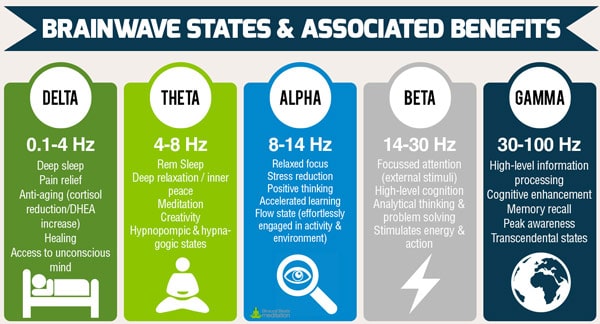

In his mind’s eye, Kekule saw a vivid image of a snake chasing its own tail, an image that showed him the missing molecular puzzle piece. Saying that, I have used them for sleep before and found it very effective.(There’s some debate as to whether or not he was aided by a few glasses of fine brandy).

Other people use them for deep sleep, but I personally have trouble “falling back to sleep” (during sleep insomnia) more so than the process of falling asleep (pre-sleep insomnia) so the idea of having uncomfortable headphone to remove or roll onto is a little off-putting. Usual Result: New ideas, solutions to existing problems, more clarity.Method : When trying to plan/develop/solve/create a problem or idea – I have found these 10-20 minute brainstorming meditations to be very useful.Usual Result: Easier to get into state (especially when highly distractible), although sometimes this makes me too relaxed and unable to stay “on track” with the meditation protocol.Method: 10-30 minute mediation with theta waves.Mediations: (theta waves) – I have found this can help meditations but also other times can put me to sleep.Usual Result:faster to fall asleep & more refreshed when using theta waves.Method: Theta waves – 20 minute nap – Shot of coffee prior to nap – cover eyes so it is dark!.Power naps: (theta waves) – Some days you need a ‘reboot’ – I personally feel like the 20 minute investment for 4-8 hours of good smooth energy that follows is a worthwhile trade, especially when the other option feels like paddling upstream (some days the 5am wakeups catch up with you).Usual Result: Longer more focused reading sessions – less distractible and more in “flow”.Method: Read / Audio book with Spotify playing a loop-able alpha tone in the background.Background Tone for Reading Books – (alpha waves).Usual Result: Faster to get into “state”, more concentrated, usual feeling of “I can keep working” even after the time period runs out.Method: Set a timer, set a task, remove distractions and use alpha waves.Long study periods: (alpha or beta waves) – this was very useful for exam period as Uni (how I first started using binaural beats).Side note: There are obviously so many mechanisms that are impacting the way your brain is operating – neurotransmitter balance, stress levels, our thought patterns, biological stresses, sleep deprivation etc… But for the sake of this example, let’s roll with it…īelow is a visual example of how your brainwaves become more in “sync” and you can feel these flow states. Much of how our brain is operating is dependent on what “State” our brain wave frequencies are in, but this GAP you are noticing between one activity and another is the transition into a new (more synchronised) state. There is a GAP there between one state and the next state. You may have also noticed that it takes some time to quiet the chatter of your brain when you lay down to nap or rest?

Have you ever noticed it can take you 5-10 minutes to really feel like you are “in the zone” when you start reading? There are 5 ‘zones’ of frequencies that have been shown to provide slightly different benefits delta, theta, alpha, beta and gamma (more details below) There is a slight difference between the left and right frequency, and the difference is measured in Hz. It makes use of the fact that the right and left ear each receive a slightly different frequency tone, yet the brain perceives these as a single tone.īinaural beats are simply just 2 different sound waves (one in each ear) playing at different frequencies. Binaural beat therapy is an emerging form of sound wave therapy.


 0 kommentar(er)
0 kommentar(er)
